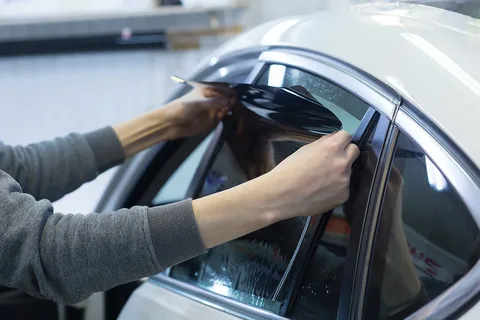How Can Auto Glass Tinting Protect You From UV Rays

When we think about car safety, we often focus on seatbelts, airbags, or strong brakes. But there’s another important feature that keeps you safe every time you drive, and that is auto glass tinting. Many people see tinted windows as only a style choice, but in reality, they serve a much bigger purpose. One of the most powerful benefits of auto glass tinting is its ability to protect you from harmful UV rays.
Let us explore in detail how tinting works, why UV protection is so important for your health, and how tinted glass keeps both you and your car safe for years to come.
Understanding UV Rays and Their Effects

What Are UV Rays?
UV stands for ultraviolet, a type of invisible light that comes from the sun. While sunlight gives us warmth and vitamin D, UV rays are very strong and can damage our skin, eyes, and even items inside our car.
Different Types of UV Rays
There are three main kinds of UV rays:
-
UVA rays: These penetrate deep into the skin and are responsible for long-term damage like aging and wrinkles.
-
UVB rays: These are stronger and cause sunburns. They can also increase the risk of skin cancer.
-
UVC rays: These are mostly absorbed by the earth’s atmosphere and usually don’t reach us.
The most dangerous ones for drivers are UVA and UVB rays.
How UV Rays Enter Your Car
You might think sitting inside a car protects you from the sun, but ordinary glass does not block all UV rays. While the windshield blocks most UVB rays, the side and rear windows allow a large portion of UVA rays to pass through. This means your skin and eyes can still be exposed while driving.
The Link Between Driving and Sun Exposure
The Hidden Risk for Drivers
If you spend hours on the road daily, your skin may be exposed to sunlight more than you realize. Many drivers notice their left arm and face (on the side of the window) aging faster than the rest of their body. This uneven exposure is a clear sign of how damaging UV rays can be.
Health Risks of UV Exposure While Driving
-
Premature aging: Wrinkles, dark spots, and sagging skin.
-
Eye problems: Cataracts and blurred vision over time.
-
Skin cancer: Constant exposure raises the risk of skin cancer, especially on exposed body parts.
This makes auto glass tinting not just a style choice, but a protective measure for your health.
How Auto Glass Tinting Works Against UV Rays
Blocking UV Penetration
Auto glass tinting is done by applying a thin film to your car windows. High-quality tints can block up to 99% of harmful UVA and UVB rays. This means you can drive longer without worrying about sun damage.
Acting as a Sunscreen for Your Car
Think of tinted windows as a permanent sunscreen. Unlike applying cream daily, tinting works round the clock, keeping harmful rays away every time you step into your car.
Types of Tints That Provide UV Protection
Not all tint films are the same. Some focus only on style, while others provide true protection. The most effective for UV protection include:
-
Dyed tint film: Basic and affordable but less effective against strong UV rays.
-
Metalized tint film: Reflects sunlight, good for UV protection, but may interfere with signals.
-
Carbon tint film: Provides strong protection without signal interference.
-
Ceramic tint film: The best option, blocks 99% of UV rays and reduces heat significantly.
Benefits of Auto Glass Tinting Beyond UV Protection
Protecting Your Skin and Health
With tinting, you lower the risk of skin problems, sunburns, and long-term diseases caused by UV exposure.
Reducing Heat Inside the Car
UV rays also bring heat into your car. Tinting reduces heat buildup, making your ride more comfortable and saving energy on air conditioning.
Extending Car Interior Life
Just like UV rays harm your skin, they also harm your car’s interiors. The dashboard, leather seats, and fabrics fade or crack when exposed to direct sunlight. Tinting keeps them safe and helps maintain a new look for longer.
Improving Driving Comfort and Safety
A cooler car and reduced glare from sunlight help you focus better on the road. Less glare means less eye strain and safer driving conditions.
Choosing the Right Auto Glass Tint for UV Protection
Factors to Consider
When selecting a tint for UV safety, consider these key points:
-
UV protection rating: Choose a film that blocks at least 99% of UVA and UVB rays.
-
Heat rejection: Pick a tint that reduces heat as well.
-
Legal limits: Every city or country has rules on how dark a tint can be. Always check before installation.
-
Quality and warranty: High-quality tints last longer and provide better protection.
Professional Installation vs DIY
Some people try applying tint film at home, but professional installation ensures:
-
No bubbles or peeling.
-
Even application.
-
Long-lasting results.
-
Proper compliance with legal rules.
Myths About Auto Glass Tinting and UV Protection
Myth 1: All Car Glass Blocks UV Rays
Reality: Standard glass blocks UVB rays but lets UVA rays pass through. Only tinted or treated glass offers strong protection.
Myth 2: Darker Tint Means Better UV Protection
Reality: Tint darkness is not the same as UV protection. Even a light ceramic tint can block nearly all UV rays.
Myth 3: Tinting Is Just for Looks
Reality: While tinted windows do make a car look stylish, their main benefit lies in protection and comfort.
Everyday Situations Where Tinting Helps
Long Highway Drives
Drivers on long journeys are exposed to direct sun for hours. Tinting reduces this exposure.
City Traffic Jams
Even at slow speeds or when stuck in traffic, UV rays penetrate your skin. Tinted windows reduce this constant risk.
Protecting Kids and Pets
Children and pets have more sensitive skin. Auto glass tinting keeps them safe during rides.
Maintaining Auto Glass Tint for Long-Term UV Protection
Cleaning Tips
-
Use a soft cloth and mild cleaners.
-
Avoid sharp objects or strong chemicals that can damage the film.
Avoiding Damage
-
Don’t roll down windows for a few days after installation.
-
Avoid sticking sharp accessories or decals on tinted glass.
Regular Inspections
Check for bubbles, peeling, or fading. If the film loses its clarity, consider replacing it.
The Long-Term Value of Auto Glass Tinting
Health Savings
By protecting your skin and eyes, tinting saves you from future medical expenses related to UV damage.
Car Maintenance Savings
A protected car interior lasts longer, reducing repair or replacement costs for seats, dashboards, and electronics.
Higher Resale Value
A well-maintained car with tinted windows often has a better resale price because the interiors remain in great condition.
Final Thoughts
Auto glass tinting is much more than a cosmetic upgrade for your car. It is a layer of protection that shields you, your family, and your vehicle from the harmful effects of UV rays. With benefits ranging from healthier skin and cooler interiors to longer-lasting car parts, tinting is an investment that pays off every day you drive.
When choosing auto glass tinting, always go for high-quality films that guarantee maximum UV protection. Combine this with professional installation, and you will enjoy not just comfort, but also peace of mind knowing that you are safe from the invisible yet dangerous rays of the sun.
Windmaster provides best in industry AUTOGLASS services for private and commercial vehicles including passenger transportation, luxury, off-road and customized vehicles. Windmaster have the capability to work on armored vehicle glass installation, industrial equipment glass maintenance, rough terrain vehicles, yachts and high raised cranes.
For more insightful articles related to this topic, feel free to visit: mifinder.co
- Art
- Causes
- Crafts
- Dance
- Drinks
- Film
- Fitness
- Food
- Games
- Gardening
- Health
- Home
- Literature
- Music
- Networking
- Other
- Party
- Religion
- Shopping
- Sports
- Theater
- Wellness


